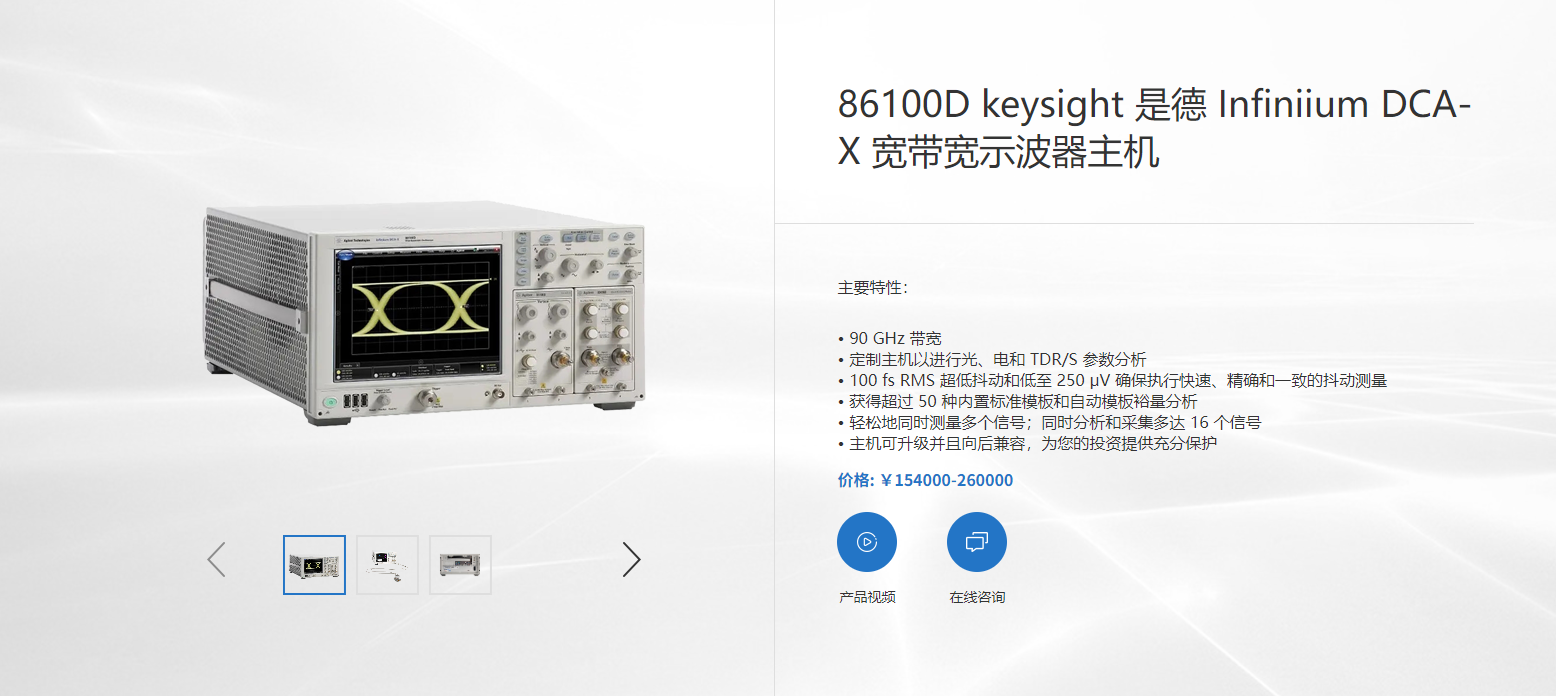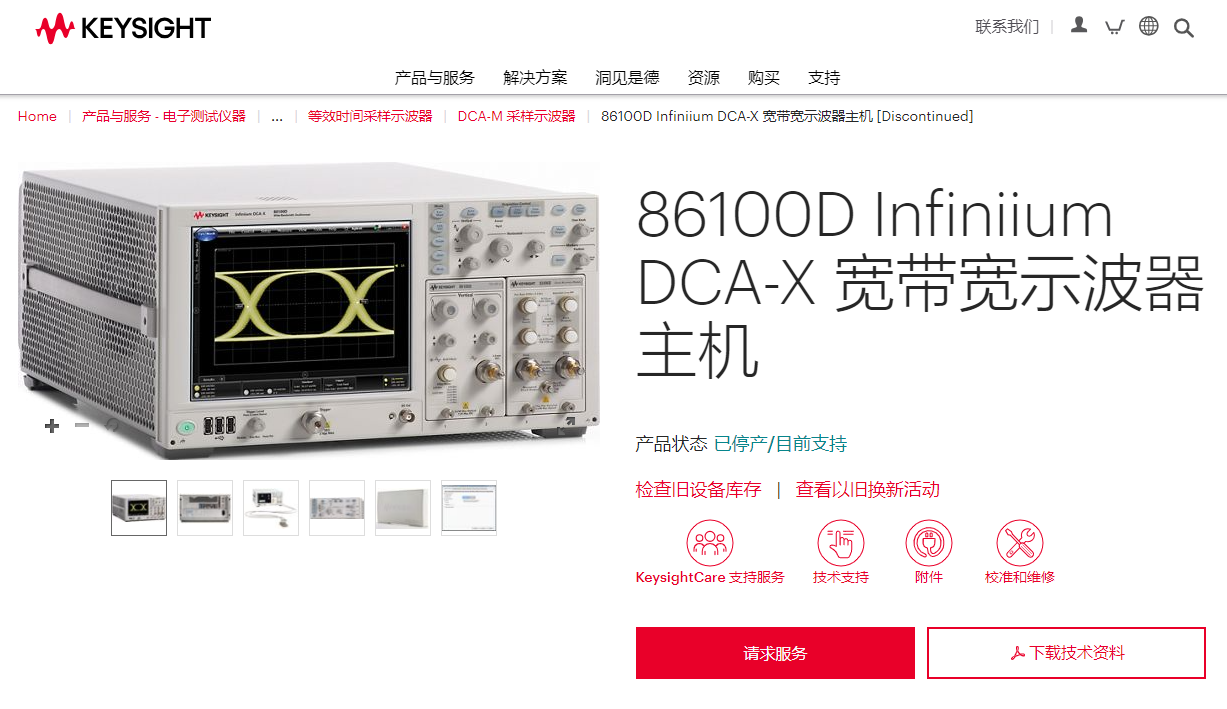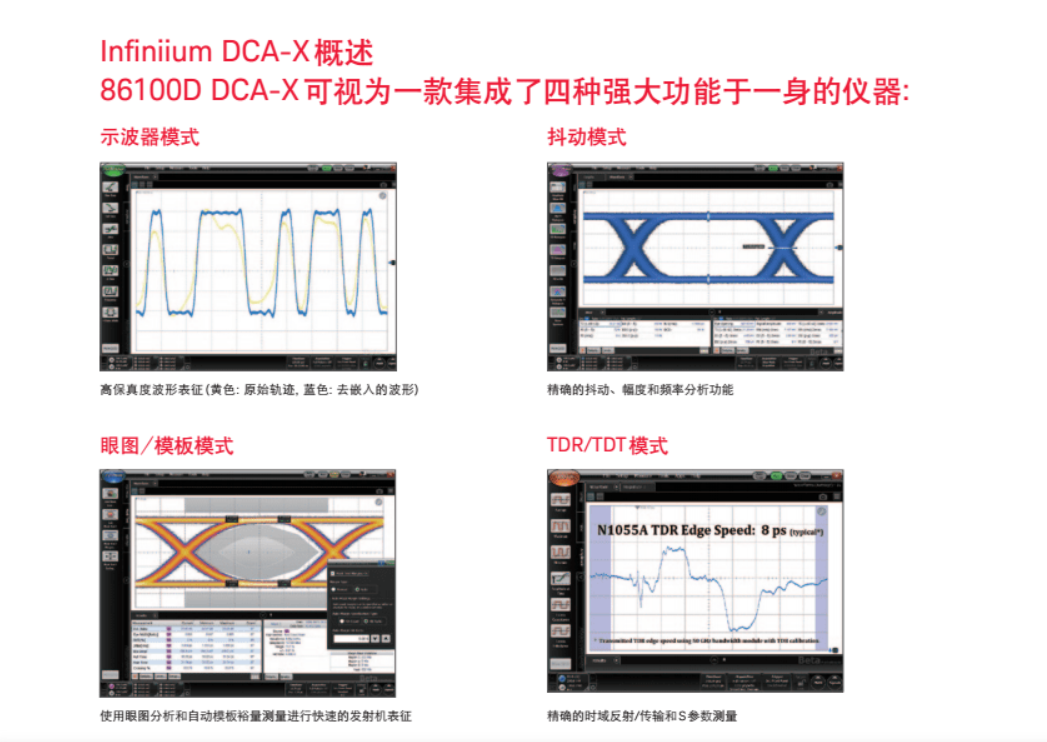How to use keysight 86100D to test eye chart? What are the application scenarios?
keysight 86100D test eye diagram (86100A/B/C ditto)
- Choose the right hardware configuration with the appropriate bandwidth, sensitivity, and clock recovery of the module for your signal type and rate. For example, for a PAM-4 signal up to 32 GBaud, you can choose the dual 50 GHz electrical bandwidth module 86108B or the 34 GHz optical bandwidth module 86105D-281
- Connect your source to the DCA-X mainframe and open the FlexDCA user interface. Select Eye/Mask mode and set up the Trigger, Time Base, Vertical and Horizontal parameters.
- In Eye/Mask mode, you can perform various measurements on the eye diagram, including eye width, eye height, eye skew, level magnitude, level noise, level skew, etc. You can also use the built-in standard mask or customized mask to perform mask test.
- If a more in-depth analysis of the PAM-4 signal is required, the 86100D-9FP PAM-N Analysis Software can be used, which provides additional functions such as linearity measurement, equalizer setting, phase noise analysis, etc. The 86100D-9FP PAM-N Analysis Software can also be used to perform mask tests using the built-in standard masks or custom masks.
- If jitter and amplitude analysis of PAM-4 signals is required, the 86100D-200/300 software option can be used, which provides accurate jitter spectrum, jitter component, and amplitude component analysis of IEEE JP03 modes.
- It can be used if de-embedding, embedding, or emulation of PAM-4 signals is required, and it allows you to add or remove channel effects to the measured or emulated signal.

What are the application scenarios for the aglient 86100D?
The 86100D is a high-performance broadband oscilloscope that provides precise and accurate measurements of high-speed digital designs from 50 Mb/s to more than 80 Gb/s. It has several application scenarios:
- Optical transceiver design and production testing. it provides eye diagram analysis, reference receiver, mask testing, and measurements in compliance with various industry standards.
- Design and characterization of electronic ASICs/FPGAs/ICs, which can provide functions such as waveform analysis, jitter analysis, phase noise analysis, equalizer settings, and the ability to de-embed, embed, or emulate signals.
- TDR/TDT/S-parameter serial bus design, cable and PCB channel characterization, which provides time-domain reflection/transfer impedance and S-parameter measurements, as well as the ability to de-embed, embed, or simulate channel effects.

What are the other features of the KEYSIGHT 86100D?
The 86100D has a number of other features in addition to the ones I mentioned before, listed below, depending on requirements:
- It can provide comprehensive de-embedding/embedding functions, using the 86100D-SIM InfiniiSim-DCA license, to remove or add line or device effects to the signal to more accurately assess the quality of the signal.
- It can provide advanced signal processing such as filtering, FFT, differential, and integration functions that allow different transformations and manipulations of the signal to better analyze its characteristics.
- It can provide new measurement functions including Data Dependent Pulse Width Shrinkage (DDPWS), Uncorrelated Jitter (UJ), J2, J9, etc., which allow for more in-depth analysis and quantification of signal jitter and noise.
- It can provide phase noise/jitter spectrum analysis, phase-locked loop (PLL) analysis, custom analysis (MATLAB), etc., which allows more professional evaluation and optimization of signal phase stability, clock synchronization, custom algorithms, and so on.

keysight 86100D test eye diagram (86100A/B/C ditto)
- Choose the right hardware configuration with the appropriate bandwidth, sensitivity, and clock recovery of the module for your signal type and rate. For example, for a PAM-4 signal up to 32 GBaud, you can choose the dual 50 GHz electrical bandwidth module 86108B or the 34 GHz optical bandwidth module 86105D-281
- Connect your source to the DCA-X mainframe and open the FlexDCA user interface. Select Eye/Mask mode and set up the Trigger, Time Base, Vertical and Horizontal parameters.
- In Eye/Mask mode, you can perform various measurements on the eye diagram, including eye width, eye height, eye skew, level magnitude, level noise, level skew, etc. You can also use the built-in standard mask or customized mask to perform mask test.
- If a more in-depth analysis of the PAM-4 signal is required, the 86100D-9FP PAM-N Analysis Software can be used, which provides additional functions such as linearity measurement, equalizer setting, phase noise analysis, etc. The 86100D-9FP PAM-N Analysis Software can also be used to perform mask tests using the built-in standard masks or custom masks.
- If jitter and amplitude analysis of PAM-4 signals is required, the 86100D-200/300 software option can be used, which provides accurate jitter spectrum, jitter component, and amplitude component analysis of IEEE JP03 modes.
- It can be used if de-embedding, embedding, or emulation of PAM-4 signals is required, and it allows you to add or remove channel effects to the measured or emulated signal.

What are the application scenarios for the aglient 86100D?
The 86100D is a high-performance broadband oscilloscope that provides precise and accurate measurements of high-speed digital designs from 50 Mb/s to more than 80 Gb/s. It has several application scenarios:
- Optical transceiver design and production testing. it provides eye diagram analysis, reference receiver, mask testing, and measurements in compliance with various industry standards.
- Design and characterization of electronic ASICs/FPGAs/ICs, which can provide functions such as waveform analysis, jitter analysis, phase noise analysis, equalizer settings, and the ability to de-embed, embed, or emulate signals.
- TDR/TDT/S-parameter serial bus design, cable and PCB channel characterization, which provides time-domain reflection/transfer impedance and S-parameter measurements, as well as the ability to de-embed, embed, or simulate channel effects.

What are the other features of the KEYSIGHT 86100D?
The 86100D has a number of other features in addition to the ones I mentioned before, listed below, depending on requirements:
- It can provide comprehensive de-embedding/embedding functions, using the 86100D-SIM InfiniiSim-DCA license, to remove or add line or device effects to the signal to more accurately assess the quality of the signal.
- It can provide advanced signal processing such as filtering, FFT, differential, and integration functions that allow different transformations and manipulations of the signal to better analyze its characteristics.
- It can provide new measurement functions including Data Dependent Pulse Width Shrinkage (DDPWS), Uncorrelated Jitter (UJ), J2, J9, etc., which allow for more in-depth analysis and quantification of signal jitter and noise.
- It can provide phase noise/jitter spectrum analysis, phase-locked loop (PLL) analysis, custom analysis (MATLAB), etc., which allows more professional evaluation and optimization of signal phase stability, clock synchronization, custom algorithms, and so on.








